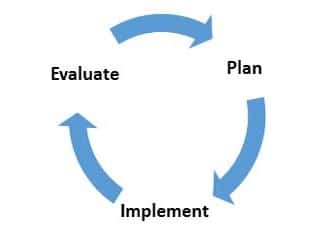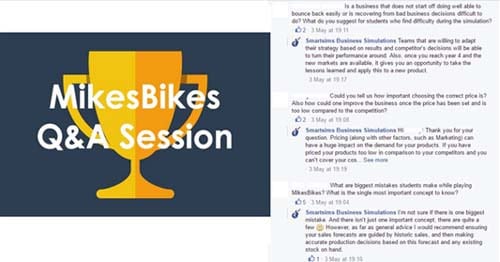Research has found that inquisitive people are generally judged to be more intelligent and engaged. What does this mean? Don’t be afraid to ask questions and take every opportunity to do so. This is certainly one of the best methods to gain knowledge and develop your understanding. Here are some questions from a previous Q&A session that we held recently. For those who have missed this, here’s your chance to see if any of the questions you wished to ask have been answered and this could also be the perfect opportunity to give you a better understanding of the concepts raised in the Q&A session and in MikesBikes-Intro as a whole.If there’s a Q&A session coming up for your course, we would strongly suggest that you participate and grab the chance to learn more!
Question #1:

There aren’t just one or two qualities that will make you the most successful in MikesBikes-Intro. It is your ability to evaluate, plan and implement your strategy, based from all the information available to you. This will mean you need to consider the market as a whole; the decisions of your competitors and the sensitivities of your target market segments.
You cannot run a business half-heartedly. Good decisions cannot be made at the last minute. You have to invest time and think about every decision that you put into your firm in order to succeed.
Developing and implementing effective business decisions are built through many models but this is the one we find is the easiest to understand and most effective with Smartsims’ simulations:

1. Evaluate the Economic Conditions and your Competitor’s Action
Read the Key Reports availble in the simulation. This will provide you with useful information about the current market, your firm’s results and your competitor’s actions.Read the Key Reports availble in the simulation. This will provide you with useful information about the current market, your firm’s results and your competitor’s actions.
- Key Reports:
- Industry Benchmark
- Market Information
- Income Statement
- Cashflow Statement
- Market Summary (All Product Details)
- Products – Sales, Margin, Production
- Factory Report
- Multifirm Retailer Margin and Extra Support
- Conduct Market Research. Valuable research has been conducted to investigate what your customers are looking for in the products they buy.
- You can also consider conducting a PESTEL (Political, Economic, Social, Technological, Environmental and Legal) analysis to give you a further overview of the different factors that your firm needs to take into consideration.
- Read the player’s manual and watch the tutorial videos. These resources explain the simulation in greater detail and display how to read the information provided to you.
2. Plan based on your evaluation
- Develop a business strategy utilizing marketing, operations, finance and product development. Ask yourself if this is the best strategy that you can come up with in regards to the current situation. What are the consequences of these decisions? What are the pros and cos of these plans? Conduct a SWOT (Strengths, Weaknesses, Opportunities and Threats) analysis and see what would work best based on what you would want to achieve.
- Always think ahead. Your plans would not always work the way you want them to, so it’s important to have an alternative idea just in case things don’t go your way.
3. Implement based on your plan
- Look at the Player’s Manual and Videos to learn how to best implement your strategy.
- Enter your decisions.
- Check the current decisions report to ensure everything is entered correctly.
- Once implemented and the rollover has occurred, you can begin the process again at the evaluation of your results and the current market.
Things to avoid
We wouldn’t say there are specific things that you need to avoid because it’s all a learning process for everyone and every market is unique. Just ensure that you have a clear strategy from the very beginning, you have conducted research and that you learn from your mistakes.
In the end, your success will be determined by how well you promote your company as an established, competent, and enterprising bicycle manufacturer. You can achieve this by evaluating the market (i.e. considering the sensitivities of the market segments), planning and implementing your strategy. Lastly, learning from your mistakes and working hard to achieve your goals would help you succeed in the simulation.
Question #2:
Two words: Very important. Katharine Paine once said, “The moment you make a mistake in pricing, you’re eating into your reputation or profit.”
Firstly, let’s talk about what the retail price is. This is the price that you recommend to your retailers sell your product for. Your pricing changes should be aligned to your current strategy and coordinated with other decisions such as advertising, PR, production, capacity, and quality (e.g. high cost/low volume, low cost/high volume, medium cost/medium volume).
Once you understand what retail price is, you need to evaluate whether you have correctly priced your products. If you price your products poorly, then you could be missing out on profits in every bike you sell, not to mention the amount of customers that you are not able to reach.
To evaluate your Pricing Strategy, you will need to take into account the price sensitivity of consumers in your target segments and the price of competing products. View the “Market Summary Report” and ask yourself does your product, in comparison to your competitors, does your product have low awareness, low quality, low distribution or low delivery (or all of the above)? If your answer is “yes”, then you should price your product at the lower end of the market, if not and demand for your product is still average to high, then you can price your products at the higher end of the market. Keep in mind that extreme prices, high or low, will have a negative effect on Gross Margins.
In summary, pricing plays a huge part on how customers perceive your products. It is one of the more influential decisions on sales and profit; changes to price should align with your overall strategy and the sensitivities of your consumers.
Question #3:

It is not difficult at all. As Arianna Huffington once said, “we need to accept that we won’t always make the right decisions, that we’ll screw up royally sometimes – understand that failure is not the opposite of success, it is a part of success.”
Use a poor start to the simulation as the chance to learn. Often, those who fail, learn more than those who don’t.
What do we suggest?
Begin by remembering that the success of a company depends heavily on the dynamics of the market and your response. Therefore, you need to adapt to the market as it shifts in order to lead a successful business.
Next, learn to recognize all the components of a company and the effects of every individual decision. Whether the decision concerns Distribution or which market segments you choose to enter, every component is critical and should not be left unexplored.
Here are some common factors that might affect your business in various ways:
- Strategic Risks – These affect your firm’s capability to achieve the goals in the business plan. This could be due to the impact of changes in consumer demand. These factors could pose as threats as they can alter how customers perceive your product(s). Based on these, customers might think that the product is overpriced, outdated (for example, you have not conducted product development in years, which resulted to a very low product specification index in comparison to your competitors) and/or your product does not meet the sensitivities of your consumers.
- Innovation – Your business needs innovation in order to keep up with your competitors. It is essential to be one step ahead. Innovation stems from every area of business. For example (within the simulation), you could consider launching into new market segments from Year 4 onwards or modify your existing bikes every couple of years to improve the specifications or reduce unit prime cost.
- Financial Risks – The financial risks are contingent on the financial structure of your business. It is important to ensure that you have sufficient cash, equity and resources to implement your decisions and strategies. For example, you can consider long-term debt (say in the third decision round) if you require more cash to execute your decisions, but be careful not to send your firm into insolvency with too much debt you cannot service.
- Operations – This refers to your firm’s ability to produce the desired amount of bikes at the desired quality in the most efficient manner. It is important to calculate the right amount of factory capacity for your firm as under producing has the potential to lead to issues such as lost sales due to lack of stock.
These are the kinds of things that you need to consider to ensure the success of your firm.
Overall, teams that are willing to adapt their strategy based on continuous analysis and competitor’s actions will be able to turn their performance around. In addition to that, once you reach Year 4 and the new markets become available your team will have an opportunity to take the lessons learned and apply this to a new product.
Essentially, in order to bounce back from making bad decisions, you have to analyze your current situation and take this into account when planning ahead. Implement your strategic decisions, be sure to follow the sensitivities of your consumers and adapt your strategy with your competitor’s actions.
In Summary
Conrad Hilton said, “Success seems to be connected with action. Successful people keep moving. They make mistakes, but they don’t quit.”
Success starts within you. You have the power to achieve your goals, if you have the will to try and do what needs to be done in order to get there. Start by asking questions, conducting research and giving your best in everything that you do.
If you have any questions, please feel free to click here and fill out a form or email us at help@smartsims.com.
By Camille Canuto

